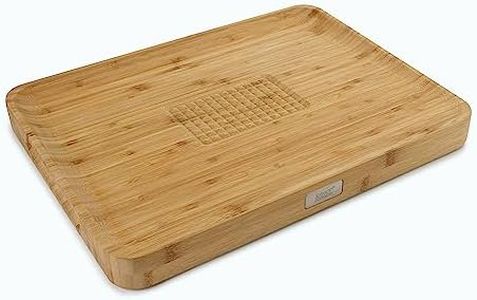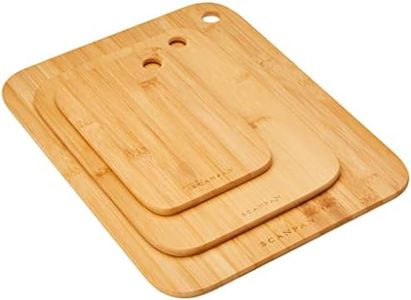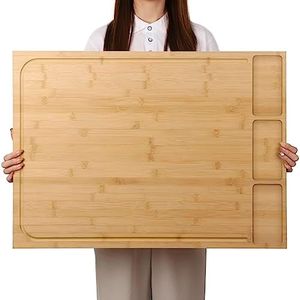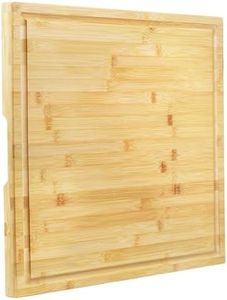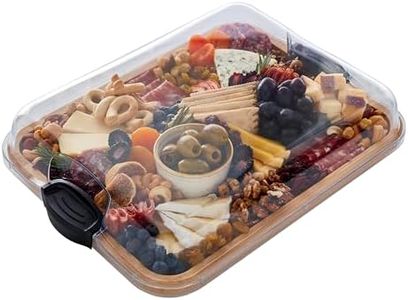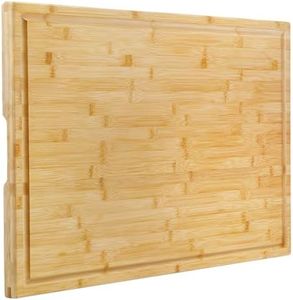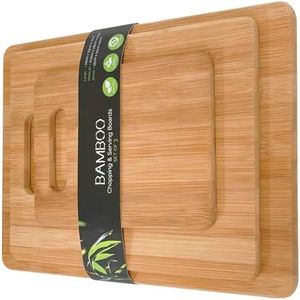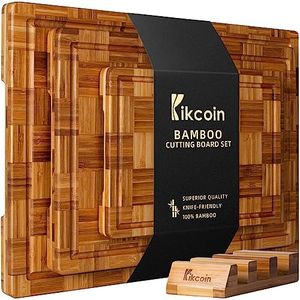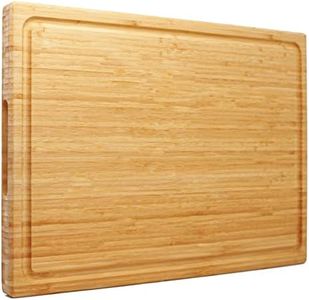We Use CookiesWe use cookies to enhance the security, performance,
functionality and for analytical and promotional activities. By continuing to browse this site you
are agreeing to our privacy policy
10 Best Bamboo Cutting Boards
From leading brands and best sellers available on the web.Buying Guide for the Best Bamboo Cutting Boards
Choosing the right bamboo cutting board can really enhance your cooking experience. Bamboo is a popular choice because it's eco-friendly, renewable, and generally kind to knives while being sturdy enough for regular use. To find a cutting board that works best for you, it's important to think about how you cook, what you plan to chop most often, and your kitchen habits. Let’s walk through the key features and how they can affect your daily use.Board SizeThe size of a bamboo cutting board is crucial because it directly affects how easily you can chop, prep, and move food around in your kitchen. Sizes generally range from small (around 8x6 inches), suitable for simple tasks like slicing fruit or preparing a sandwich, to extra-large boards (over 18x12 inches) that handle big meal preps and can hold large items like roasts or multiple ingredients at once. To pick the right size for you, consider your kitchen counter space, how much food you typically prepare, and if you need a lightweight board that can fit into the dishwasher or sink. If you mostly make snacks or have a small kitchen, a smaller board works well. For batch cooking, family meals, or larger cuts of meat, go for a bigger board.
ThicknessThe thickness of the cutting board affects how stable and durable it is. Thinner boards (under 1/2 inch) are lightweight and easy to store but may warp over time or slide around while you chop. Medium thickness (between 1/2 and 1 inch) offers a good balance between sturdiness and manageability. Thicker boards (over 1 inch) are very stable, less likely to warp, and great for heavy-duty chopping, though they can be heavier and bulkier to handle. If you want something portable and easy to wash, a thinner board may be best. For heavy or daily use, a thicker board is more reliable.
Juice GrooveA juice groove is a shallow channel running around the edge of the board that catches liquids from fruits, veggies, or meats. This feature can help keep your countertop clean and is especially useful if you prepare juicy foods. Boards without grooves give you a larger flat surface, which can be better for bakers working dough or for general chopping. If you deal with a lot of juicy foods or want to minimize spills, look for a board with a juice groove. If you mostly chop dry items or prefer an uninterrupted work space, choose one without.
Bamboo Construction (Solid vs. Laminated)Bamboo boards can either be made from single, solid strips of bamboo or from multiple layers glued together, known as laminated. Laminated bamboo is more common and creates a durable board that's less likely to crack or warp, while solid bamboo has a more natural look but might be less consistent in quality and durability. If you prefer a sturdy, consistent board, laminated construction is typically better. For those who value aesthetics and traditional feels, a solid board might be appealing.
Maintenance and FinishSome bamboo boards come pre-treated with oils or a protective finish, which helps resist stains and water damage. Others may require you to season them periodically with food-safe mineral oil to keep them from drying out. Consider how much maintenance you’re willing to do; a pre-finished board needs less effort, while an unfinished one lets you control the seasoning process but requires regular oiling. If you want low-maintenance, go with a finished board; if you're okay with occasional upkeep for longevity, unfinished boards work too.
WeightWeight affects how portable and stable your cutting board is. Lighter boards are easier to carry, store, and wash, but they might move around on the counter. Heavier boards stay firmly in place during chopping but are more difficult to lift. If you value quick clean-up and portability, a lighter board will be convenient. If you want something steady for more forceful cutting jobs, pick a heavier board.


